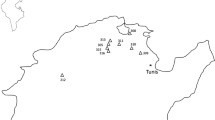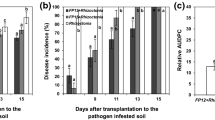Abstract
Sclerotinia sclerotiorum is a necrotrophic, phytopathogenic, filamentous ascomycete with a broad host range and a worldwide distribution. Application of fungicides is the principal tool for controlling Sclerotinia diseases on most crops. Unfortunately, the extensive use of a single fungicide selects for resistant populations and leads to control failures. The phenylpyrrole fungicide fludioxonil has been reported to have high activity against S. sclerotiorum and to control Sclerotinia stem rot in rapeseed. In this study, biochemical characteristics of laboratory-induced mutants of S. sclerotiorum were determined. The results indicated that the fludioxonil-resistant mutants were sensitive to osmotic stress (high sugar). Compared to the wild-type strains, the fludioxonil-resistant mutants had a significant increase in cell membrane permeability, glycerol and oxalate content, and phenylalanine ammonia-lyase and peroxidase activity, but did not differ in exopolysaccharide content. Sequencing indicated that three wild-type strains were identical, and the mutants SZ45R and HA61R had a single point mutation while NT18R had both a single point mutation and a frameshift in the amino acid sequence coded by the two-component histidine kinase gene (Shk1, SS1G_12694). Therefore, we concluded that the biological differences between the resistant mutants and the wild-type strains may be related to mutation in Shk1. The information will increase our understanding of the resistance mechanism of S. sclerotiorum to fludioxonil and could provide new reference data for the management of Sclerotinia stem rot caused by S. sclerotiorum.




Similar content being viewed by others
References
Alex L, Borkovich K, Simon M (1996) Hyphal development in Neurospora crassa: involvement of a two-component histidine kinase. P Natl Acad Sci USA 93:3416–3421
Assis JS, Maldonado R, Munoz T, Escribano MI, Merodio C (2001) Effect of high carbon dioxide concentration on PAL activity and phenolic contents in ripening cherimoya fruit. Postharvest Biol Tec 23:33–39
Bardin SD, Huang HC (2001) Research on biology and control of Sclerotinia diseases in Canada. Can J Plant Pathol 23:88–98
Barrere GC, Barber CE, Daniels MJ (1986) Molecular cloning of genes involved in the production of the extracellular polysaccharide xanthan by Xanthomonas campestris pv. campestris. Int J Biol Macromol 8:372–374
Beever RE (1983) Osmotic sensitivity of fungal variants resistant to dicarboximide fungicides. Trans Br Mycol Soc 80:327–331
Beever RE, Brien HMR (1983) A survey of resistance to the dicarboximide fungicides in Botrytis cinerea. New Zea J Agr Res 26:391–400
Boland GJ, Hall R (1994) An index of host plant hosts susceptible to Sclerotinia sclerotiorum. Can J Plant Pathol 16:93–108
Chen Y, Zhang AF, Gao TC, Zhang Y, Wang WX, Ding KJ, Chen L, Sun Z, Fang XZ, Zhou MG (2012) Integrated use of pyraclostrobin and epoxiconazole for the control of Fusarium head blight of wheat in Anhui Province of China. Plant Dis 96:1495–1500
Coplin DL, Cook D (1990) Molecular genetics of extracellular polysaccharides I vascular phytopathogenetic bacteria. Mol Plant Microbe In 41:459–472
Cui W, Beever RE, Parkes SL, Weeds PL, Templeton MD (2002) An osmosensing histidine kinase mediates dicarboximide fungicide resistance in Botryotinia fuckeliana (Botrytis cinerea). Fungal Genet Biol 36:187–198
Cui W, Beever RE, Parkes SL, Templeton MD (2004) Evolution of an osmosensing histidine kinase in field strains of Botryotinia fuckeliana (Botrytis cinerea) in response to dicarboximide fungicide usage. Phytopathology 94:1129–1135
Dharmapuri S, Yashitola J, Vishnupriya MR, Sonti RV (2001) Novel genomic locus with atypical G+C content that is required for extracellular polysaccharide production and virulence in Xanthomonas oryzae pv. oryzae. Mol Plant Microbe In 14:1335–1339
Dixon RA, Paiva NL (1995) Stress induced phenylpropanoid metabolism. Plant Cell 7:1085–1097
Duan YB, Liu SM, Ge CY, Feng XJ, Chen CJ, Zhou MG (2012) In vitro inhibition of Sclerotinia sclerotiorum by mixtures of azoxystrobin, SHAM, and thiram. Pestic Biochem Phys 103:101–107
Duan YB, Ge CY, Liu SM, Chen CJ, Zhou MG (2013a) Effect of phenylpyrrole fungicide fludioxonil on morphological and physiological characteristics of Sclerotinia sclerotiorum. Pestic Biochem Phys 106:61–67
Duan YB, Ge CY, Liu SM, Wang JX, Zhou MG (2013b) A two-component histidine kinase Shk1 controls stress response, sclerotial formation and fungicide resistance in Sclerotinia sclerotiorum. Mol Plant Pathol 14:708–718
Dubois M, Gilles KA, Hamilton JK, Robers PA, Smith F (1956) Calorimetric method for determination of sugars and related substances. Anal Chem 28:350–356
Errampalli D (2004) Effect of fludioxonil on germination and growth of Penicillium expansum and decay in apple cvs. Empire Gala. Crop Prot 23:811–817
Fujimura M, Ochiai N, Ichiishi A, Usami R, Horikoshi K, Yamaguchi I (2000a) Fungicide resistance and osmotic stress sensitivity in os mutants of Neurospora crassa. Pestic Biochem Phys 67:125–133
Fujimura M, Ochiai N, Ichiishi A, Usami R, Horikoshi K, Yamaguchi I (2000b) Sensitivity to phenylpyrrole fungicides and abnormal glycerol accumulation in os and cut mutant strains of Neurospora crassa. J Pestic Sci 25:31–36
Fungicide Resistance Action Committee (2010) http://www.frac.info/frac/work/work_dica.htm. Accessed 1 August 2010
Gehmann K, Nyfeler R, Leadbeater AJ, Nevill D, Sozzi D (1990) CGA 173506: a new phenylpyrrole fungicide for broad-spectrum disease control. Proc Brighton Crop Prot Conf Pests Dis 2:369–376
Godoy G, Steadman JR, Dickman MB, Dam R (1990) Use of mutants to demonstrate the role of oxalic acid in pathogenicity of Sclerotinia sclerotiorum on Phaseolus vulgaris. Physiol Mol Plant P 37:179–191
Grindle M (1983) Effect of synthetic media on the growth of Neurospora crassa isolates carrying genes for benomyl resistance and vinclozolin resistance. Pestic Sci 14:481–491
Hagiwara D, Matsubayashi Y, Marui J, Furukawa K, Yamashino T, Kanamaru K, Kato M, Abe K, Kobayashi T, Mizuno T (2007) Characterization of the NikA histidine kinase implicated in the phosphorelay signal transduction of Aspergillus nidulans, with special reference to fungicide responses. Biosci Biotech Bioch 71:844–847
Hohmann S (2002) Osmotic stress signaling and osmoadaptation in yeast. Microbiol Mol Biol R 66:300–372
Iacomi-Vasilescu B, Avenot H, Bataillé-Simoneau N, Laurent E, Guénard M, Simoneau P (2004) In vitro fungicide sensitivity of Alternaria species pathogenic to crucifers and identification of Alternaria brassicicola field isolates highly resistant to both dicarboximides and phenylpyrroles. Crop Prot 23:461–468
Jiang AL, Tian SP, Xu Y (1984) Effect of controlled atmospheres with high-O2 or high-CO2 concentrations on postharvest physiology and storability of “Napoleon” sweet cherry. J Integr Plant Biol 44:925–930
Jones DH (1984) Phenylalanine ammonia-lyase: regulation of its induction and its role in plant development. Phytochemistry 23:1349–1360
Kamoun S, Kado CIA (1990) Plant inducible gene of Xanthomonas campestris pv. campestris encodes an exocellular component require for growth in the host and hysensitivity on nonhosts. J Bacteriol 172:5165–5172
Kanetis L, Forster H, Adaskaveg JE (2006) Fludioxonil-resistant isolates of Penicillium digitatum show diverse fitness and no relationship to osmotic stress regulation. Phytopathology 96:S58 (Abstr.)
Kojima K, Takano Y, Yoshimi A, Tanaka C, Kikuchi T, Okuno T (2004) Fungicide activity through activation of a fungal signaling pathway. Mol Microbiol 53:1785–1796
Kuang J, Hou YP, Wang JX, Zhou MG (2011) Sensitivity of Sclerotinia sclerotiorum to fludioxonil: in vitro determination of baseline sensitivity and resistance risk. Crop Prot 30:876–882
Leigh JA, Coplin DL (1992) Exopolysaccharides in plant-bacterial interactions. Annu Rev Microbiol 46:307–346
Leroux P (1996) Recent developments in the mode of action of fungicides. Pestic Sci 47:191–197
Liu YH, Liu HP, Li XF, Han JC, Liu HQ (2010) Biological, physiological and biochemical characteristics of procymidone-resistant Sclerotinia sclerotiorum. Chin Agri Sci Bull 26:277–281
Lumsden RD (1979) Histology and physiology of pathogenesis in plant diseases caused by Sclerotinia species. Phytopathology 69:890–896
Ma Z, Michailides JT (2004) Characterization of Iprodione-resistant Alternaria isolates from pistachio in California. Pestic Biochem Phys 80:75–84
Ma Z, Luo Y, Michailides TJ (2006) Molecular characterization of the two-component histidine kinase gene from Monilinia fructicola. Pest Manag Sci 62:991–998
Moller EM, Bahnweg G, Sandermann H, Geiger HH (1992) A simple and efficient protocol for isolation of high molecular weight DNA from filamentous fungi, fruit bodies, and infected plant tissues. Nucleic Acids Res 20:6115–6116
Motoyama T, Kadokura K, Ohira T, Ichiishi A, Fujimura M, Yamaguchi I, Kudo TA (2005) Two-component histidine kinase of the rice blast fungus is involved in osmotic stress response and fungicide action. Fungal Genet Biol 42:200–212
Ochiai N, Fujimura M, Motoyama T, Ichiishi A, Usami R, Horikoshi K, Yamaguchi I (2001) Characterization of mutations in the two-component histidine kinase gene that confer fludioxonil resistance and osmotic sensitivity in the os-1 mutants of Neurospora crassa. Pest Manag Sci 57:437–442
Orth AB, Sfarra A, Pell EJ, Tien M (1994) Characterization and genetic analysis of laboratory mutants of Ustilago maydis resistant to dicarboximide and aromatic hydrocarbon fungicides. Phytopathology 84:1210–1214
Préstamo G, Manzano P (1993) Peroxidases of selected fruits and vegetables and the possible use of ascorbic acid as an antioxidant. Hortic Sci 28:48–50
Purdy LH (1979) Sclerotinia sclerotiorum: history, diseases and symptomatology, host range, geographic distribution and impact. Phytopathology 69:875–880
Rao P, Pattabiraman TN (1989) Reevaluation of the phenol–sulfuric acid reaction for the estimation of hexoses and pentoses. Anal Biochem 181:18–22
Shi ZQ, Zhou MG, Ye ZY (2000) Study on Resistance Mechanism of Sclerotinia sclerotiorum to Dimethachlon. Chin J Pestic Sci 2:47–51
Steadman JR (1979) Control of plant diseases caused by Sclerotinia species. Phytopathology 69:904–907
Tu JC (1997) An integrated control of white mold (Sclerotinia sclerotiorum) of beans, with emphasis on recent advances in biological control. Bot Bull Acad Sinica 38:73–76
Viaud M, Fillinger S, Liu W, Polepalli JS, Pecheur LP, Kunduru AR, Leroux P, Legendre L (2006) A class III histidine kinase acts as a novel virulence factor in Botrytis cinerea. Mol Plant Microbe In 19:1042–1050
Yan J, Qiu TQ (2004) Determination of glycerol by cupric glycerinate colorimetry. China Oils Fats 29:40–43
Yao H, Tian S (2005) Effects of a biocontrol agent and methyl jasmonate on postharvest diseases of peach fruit and the possible mechanisms involved. J Appl Microbiol 98:941–950
Yoshimi A, Tsuda M, Tanaka C (2004) Cloning and characterization of the histidine kinase gene Dic1 from Cochliobolus heterostrophus that confers dicarboximide resistance and osmotic adaptation. Mol Genet Genomics 271:228–236
Acknowledgments
This work was supported by the Special Fund for Agro-scientific Research in the Public Interest (201103016 and 201303023).
Author information
Authors and Affiliations
Corresponding author
Additional information
Communicated by K.J. Gorman
Ya-Bing Duan and Chang-Yan Ge are the co-first authors.
Rights and permissions
About this article
Cite this article
Duan, YB., Ge, CY. & Zhou, MG. Molecular and biochemical characterization of Sclerotinia sclerotiorum laboratory mutants resistant to dicarboximide and phenylpyrrole fungicides. J Pest Sci 87, 221–230 (2014). https://doi.org/10.1007/s10340-013-0526-6
Received:
Accepted:
Published:
Issue Date:
DOI: https://doi.org/10.1007/s10340-013-0526-6




